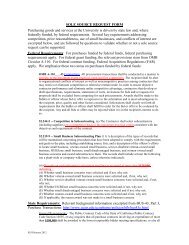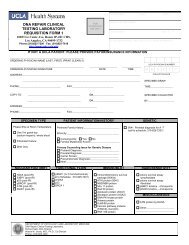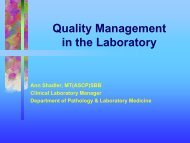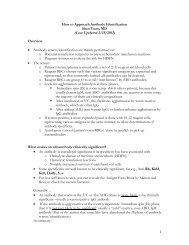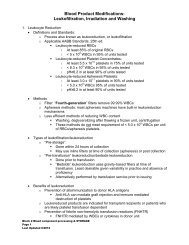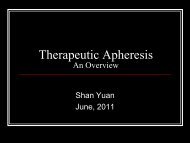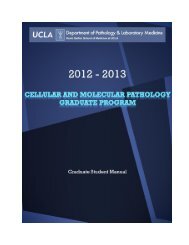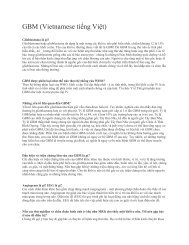TRANSFUSION MEDICINE - the UCLA Department of Pathology ...
TRANSFUSION MEDICINE - the UCLA Department of Pathology ...
TRANSFUSION MEDICINE - the UCLA Department of Pathology ...
Create successful ePaper yourself
Turn your PDF publications into a flip-book with our unique Google optimized e-Paper software.
HISTORYA 73-year-old woman underwent surgical repair <strong>of</strong> a ventral hernia. After anuneventful postoperative course, she was discharged on postoperative day 4. Aroundday 9, she developed progressive weakness, ligh<strong>the</strong>adedness, and dark urine, and had1 episode <strong>of</strong> emesis <strong>of</strong> clear fluid. She presented to <strong>the</strong> authors’ institution on day 14.Review <strong>of</strong> all o<strong>the</strong>r systems was unremarkable. Her medical history was significantfor colon cancer 7 years earlier treated with surgical resection and chemo<strong>the</strong>rapy,hypertension, hyperlipidemia, hypothyroidism, and gastroesophageal reflux disease.Her outpatient medications included carvedilol, nifedipine, captopril, losartanhydrochlorothiazide,ezetimibe-simvastatin, thyroxine, esomeprezole, ranitidine,aspirin, and tramadol.transfusion medicineTM 11-4© ASCP 2011Her vital signs were: blood pressure, 128/93 mmHg; pulse rate, 81/min; respirations,18/min; and temperature, 98.4°F (36.9°C). Oxygen saturation on room air was100%. Her abdominal wound was healing with no evidence <strong>of</strong> bleeding or infection.No skin rashes, petechiae, ecchymoses, or mucosal hemorrhages were present. Thefecal occult blood test result was negative. The rest <strong>of</strong> her physical examination resultswere unremarkable.Relevant admission laboratory results are shown in Laboratory Data. Thepatient had severe anemia with evidence <strong>of</strong> hemolysis, including reticulocytosis,unconjugated hyperbilirubinemia, a low haptoglobin level, an elevated level <strong>of</strong> lactatedehydrogenase, and hemoglobinemia. The peripheral smear showed abundantmicrospherocytes and no schistocytes. Her blood type was group A Rh+. Theantibody screen result was negative. The direct antiglobulin test (DAT) result waspositive for IgG and negative for C3. An acid elution was performed, and <strong>the</strong> eluatewas nonreactive with reagent red blood cells (RBCs). She was admitted for RBCtransfusions and evaluation <strong>of</strong> her hemolytic anemia.LABORATORY DATA.Test Patient Result Reference RangeWhite blood cell count, ×10 3 /µL (×10 9 /L) 5.50 (5.50) 3.28-9.29 (3.28-9.29)Red blood cell count, ×10 6 /µL (×10 12 /L) 1.96 (1.96) 3.76-4.93 (3.76-4.93)Hemoglobin, g/dL (g/L) 6.2 (62) 11.5-14.6 (115-146)Hematocrit, % 18.7 34.0-42.1Platelet count, ×10 3 /µL (×10 9 /L) 207 (207) 143-398 (143-398)Mean corpuscular volume, fL 95.4 79.0-95Absolute reticulocyte count, ×10 6 /µL (×10 9 /L) 0.1942 (194.2) 0.0273-0.1072 (27.3-107.2)Haptoglobin, mg/dL (µmol/L)





